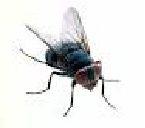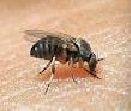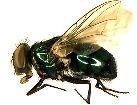Natural Solutions to Things That Bug You (53 page)
Read Natural Solutions to Things That Bug You Online
Authors: Myles Bader

Larvae are maggots with a legless soft body except for the dark mouth hooks. Pupae are dark, and look like a small barrel. Larvae will feed on decaying meat and feces. Adult flies will feed on sugary food of any kind, including nectar and rotting fruit.
Flies live in garbage and wherever animal feces are available. Dead animals attract flies within hours after death. Many birds, bats, spiders, and insects will eat the adults. Predatory and parasitic insects eat the larvae.
The eyes of flies are among the most complex in the insect world. They are compound eyes with many individual facets, each representing a separate light-detecting unit. The light reflected from the eye of a horsefly can form a rainbow.
Flies taste, smell, and feel with the hairs that cover their bodies. The hairs on the fly's mouth parts and feet are used for tasting. Flies taste what they walk on. If they walk onto something tasty, they put down their mouth and taste it again. Flies use other hairs to tell them when they touch something. These hairs bend when touched. The eyes of a fly do not have eyelids, so flies rub their eyes with their feet to keep them clean.
Flies walk on smooth surfaces using sticky soft pads that act like glue. This allows them to walk on vertical glass surfaces and upside down. Flies and other insects, such as burying beetles, are very important in consuming and eliminating dead bodies of animals. Flies are also essential in the conversion of feces and decaying vegetation into soil. Flies serve as prey to many other animals. Some flies even aid in pollination.
Because of their habits of being attracted to feces and decaying meat, flies have been implicated in transmission of disease such as dysentery, typhoid fever, and cholera.
NATURAL METHODS OF ELIMINATION
WHY IT’S HARD TO SWAT A FLY
 Houseflies have great all-round vision and can take off in any direction independently of how their body is aligned. This is one of the reasons why they are so good at evading an attack. In the instant between seeing a moving swatter and flying away, the fly's brain is able to calculate the position of the impending threat then place its legs and body in the perfect position that allows it to jump in the opposite direction.
Houseflies have great all-round vision and can take off in any direction independently of how their body is aligned. This is one of the reasons why they are so good at evading an attack. In the instant between seeing a moving swatter and flying away, the fly's brain is able to calculate the position of the impending threat then place its legs and body in the perfect position that allows it to jump in the opposite direction.
All of the action is carried out within 100 milliseconds after the fly first spots the moving swatter, which shows just how rapidly the fly's brain can process the information.
The fly possesses an internal map within its brain which converts the position of the threat into the appropriate body motion that leads to successfully evading the swatter.
MAKING FLYPAPER WITH MAPLE SYRUP
The following ingredients will be needed:

1 Tablespoon of brown sugar
1 Tablespoon of granulated sugar
¼ Cup of an inexpensive maple syrup
1 Brown paper bag
1 Cookie sheet
Place all the ingredients in a small bowl and mix thoroughly. Cut 8-inch strips, about 2 inches wide from a brown paper bag and place them on the cookie sheet. Pour the mixture over the strips and allow the strips to soak overnight. Hang up the strips where needed.
GARBAGE CANS ARE A PROBLEM
Sprinkle dry borax into garbage cans after you wash them out, this will deter and kill them if they get it on them.
BLACK FLY
 Some species of adult black fly females are fierce biters, whereas others are strictly a nuisance by their presence around one's nostrils, ears, arms, hands, and other exposed skin areas. Children are especially susceptible and may be severely bitten while adults in an area where they frequent are scarcely aware of the flies. Bites may appear where clothing fits snugly against the body, leaving a ring of bites just above or below the belt line.
Some species of adult black fly females are fierce biters, whereas others are strictly a nuisance by their presence around one's nostrils, ears, arms, hands, and other exposed skin areas. Children are especially susceptible and may be severely bitten while adults in an area where they frequent are scarcely aware of the flies. Bites may appear where clothing fits snugly against the body, leaving a ring of bites just above or below the belt line.
When the black fly finishes feeding, bleeding may continue for some time. At first, the bite site appears as a small, red, central spot surrounded by a slightly reddened, swollen area. Next, the area becomes increasingly itchy, swollen and irritating, sometimes for several days. Some species of black flies readily attack people, whereas others prefer domestic animals or birds, often feeding during the daylight hours and sometimes into the night.
Black flies may become so abundant that they are drawn into the air passages of livestock, occasionally resulting in death. It is believed that allergic reactions to bites may be caused by histaminic substances in the fly's saliva.
These flies transmit a disease of filarial worms, onchocerciasis, which causes blindness in people in Mexico, Central America and Africa in addition to protozoan parasites, leucocytozoonosis to turkeys and wild birds.
They may also be potential transmitters of encephalitis and as with many aquatic insects, black flies are very sensitive to water pollution. Most species of adult black flies are about 1/8-inch long (2 to 5mm), black gray or even yellow colored, broad clear winged without hairs or scales with heavy veins near the anterior wing margin, have short 11 segmented antennae and large round eyes.
Black flies often occur in enormous numbers in the spring and early summer months, especially in the northern latitudes. Bites can be extremely painful, and their mouthparts are somewhat similar to those of a horse fly (bladelike and piercing) in the female. Mouth parts are rudimentary in the male.
When they get on people, they crawl into sleeves, under neckbands, around boot tops and other vulnerable places, especially favoring the head just beneath the rim of a hat. Bites can cause swelling and numb soreness for many days. There are records of both domestic animals and people being killed in a few hours through venomous bites and blood loss.
Death can result from suffocation as a result of plugged nasal or bronchial tubes and allergic reactions. Flies usually bite during the day in outdoor shaded or partially-shaded areas. They do not bite indoors or late at night. Some fly 7 to 10 miles from the breeding sites, or are blown by wind even further to feed on warm-blooded animals and people. Flies usually bite for about three weeks before they die. Dark blue cloth attracts more flies than white cloth.
Females deposit from 150 to 500 small, shiny, creamy-white eggs on submerged objects in the stream such as on water plants, rocks, twigs, leaves, etc. or simply scatter the eggs over the water surface. Eggs darken then hatch in four to five days at water temperatures of 70
F.
Eggs deposited in the autumn do not hatch until the following spring when the water warms.
Young larvae attach themselves to submerged objects, molting six times as they grow. They are elongate with the hind part of their bodies swollen. A head fan sweeps food material into the mouth.
They retain their position in the water by means of sucker-like discs and tiny hooks at the tip of the abdomen. Also, they may spin a fine thread which aids in anchoring them. Winter may be passed as larva.
Pupation occurs in a cocoon, open at one end. Adults emerge in two to three days when the water is warm. They are capable of immediate flight and mating. The entire life history spans about four to six weeks, depending on species, water temperature, available food, etc. There may be four generations per year.
Black flies are attracted to mammals by the carbon dioxide and moisture in exhaled breath, dark colors, convection currents, perspiration, perfumes, toiletries, etc.
BLOW FLY
 Blow flies are so-called because the larvae develop inside the bodies of dead animals, causing the carrier to have a bloated appearance. They are attracted to garbage and about the size of house flies or slightly larger. They have been called “bottle flies” because their shiny blue and green color resembling colored glass bottles, although some species are shiny black or bronze.
Blow flies are so-called because the larvae develop inside the bodies of dead animals, causing the carrier to have a bloated appearance. They are attracted to garbage and about the size of house flies or slightly larger. They have been called “bottle flies” because their shiny blue and green color resembling colored glass bottles, although some species are shiny black or bronze.
If you find a large number of these flies indoors it usually indicates the presence of a dead animal such as a mouse or bird inside the house.
When huge numbers of flies suddenly appear inside the home, home-owners become very upset and often don't know what to do. The flies often look somewhat like houseflies, but may be shiny green, blue, bronze or black.
They congregate around windows and produce a buzzing sound and blow flies lay eggs in decomposing organic matter, like garbage, animal manure, decaying vegetables, grass clippings and poorly managed compost piles.
These flies are important in nature in the decay process of animal carcasses and are usually the first insects to arrive, within hours or even minutes after an animal dies.
During the summertime, flies will lay their eggs in meat and vegetable scraps in your trashcan and can go through an entire generation in less than a week. When fly maggots finish feeding, they will often crawl away and pupate in a dark, secluded place. Sometimes these maggots or pupae are seen by homeowners who do not know what they are. Best to vacuum them and discard the bag, however, those missed will emerge later as flies.
Bottle flies typically only infest "fresh" cadavers, but there are other insects that show up later, such as rove beetles, carpet beetles and hide beetles, but a cadaver is only a good food source for bottle flies for a short period of time.
The flies are attracted to the light from windows during the day so fly strips are a non-toxic method of capturing them. Make sure your draperies or window treatments are securely tied back so the fabric doesn't get "stuck" in the sticky tape.
CARROT RUST FLY
Identification: